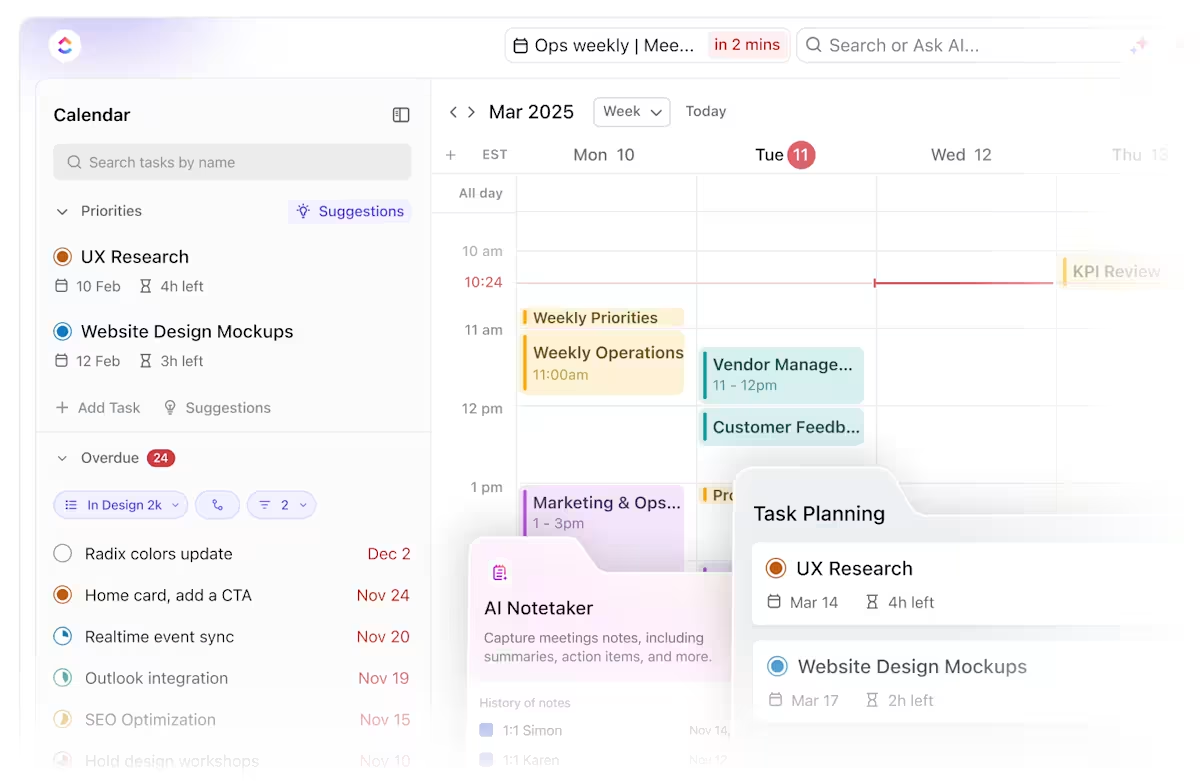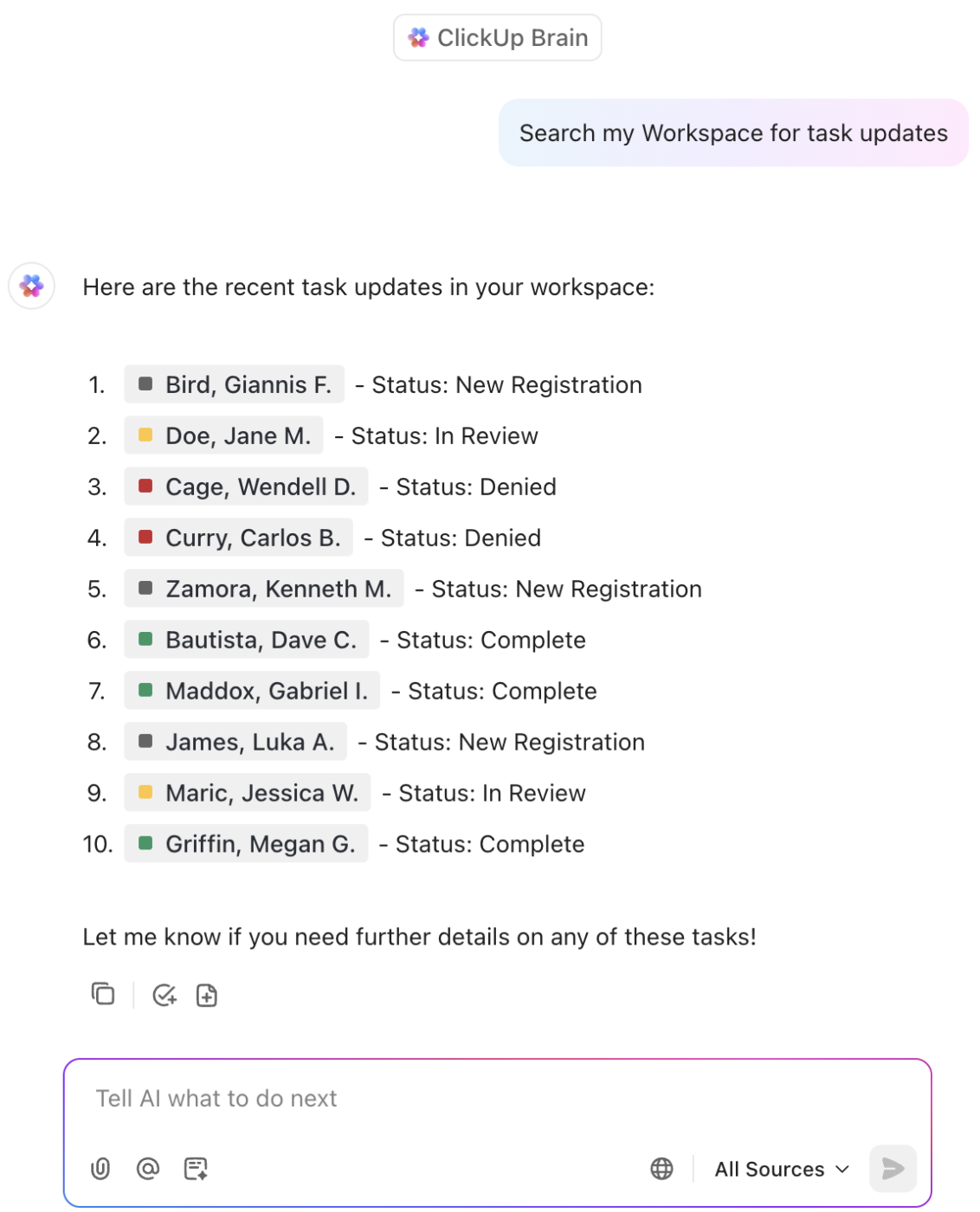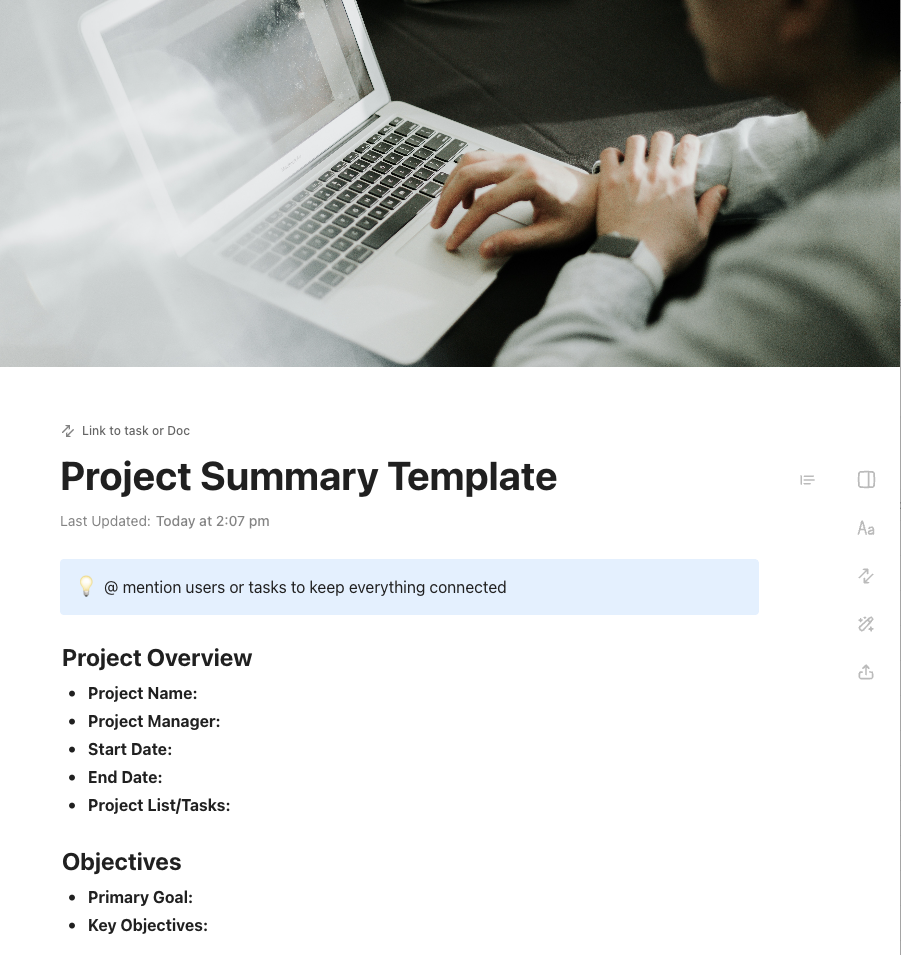إدارة المشاريع المستقلة تعني القيام بكل المهام: التخطيط والتواصل والتنفيذ، وأحيانًا حتى العلاج الذاتي (فكلنا نمر بأيام سيئة).
لا عجب أن إدارة المشاريع المستقلة أمر مرهق، خاصةً عندما لا توجد بنية مدمجة أو فريق يمكن الاعتماد عليه. إذا فاتك موعد نهائي، فسوف يفقدك عميلك. إذا نسيت مهمة ما، فسوف تظل مستيقظًا حتى الساعة 2 صباحًا لتصحيحها.
العمل يتوقف، والنطاق يتوسع، والوقت؟ يختفي بسرعة.
تقدم لك هذه المدونة خطوات عملية لتبقى منظمًا، وتواصل العمل على المشاريع، وتسلم مشاريع العمل الحر في الوقت المحدد، دون أن ترهق نفسك. هيا بنا نبدأ! 🧰
ما هي إدارة المشاريع المستقلة؟
إدارة المشاريع المستقلة هي ممارسة إدارة المشاريع بشكل مستقل دون الارتباط بجهة عمل أو مؤسسة واحدة. يتولى المحترفون المستقلون مسؤوليات إدارة المشاريع مثل تحديد الأهداف ووضع الجداول الزمنية للمشاريع وتخصيص الموارد وقيادة التنفيذ.
بدلاً من العمل في بيئة عمل داخلية، يتعاقد مديرو المشاريع المستقلون على تقديم خدماتهم لعملاء مختلفين، وفي قطاعات مختلفة، وأنواع مشاريع مختلفة. وهم مسؤولون عن التسليم، وتأمين العمل، وتحديد الأسعار، وإدارة العلاقات مع العملاء.
يتيح هذا النموذج لمدير المشروع المتمرس اختيار المشاريع التي يرغب في توليها، وتحديد ساعات عمله، والعمل عن بُعد. ولكنه يتطلب أيضًا القدرة على التكيف، وسرعة التأقلم، والتواصل الفعال لتحقيق النجاح عبر فرق متنوعة، ووصف وظيفي، وسير عمل.
🧠 حقيقة ممتعة: كانت كلمة "freelance" تصف في الأصل المرتزقة في العصور الوسطى الذين كانوا يبيعون "خدماتهم المستقلة" لمن يدفع أعلى سعر. لم يكن الأمر يتعلق بالعمل الجانبي في ذلك الوقت، بل كان يتعلق ببيع الخدمات العسكرية.
لماذا يحتاج المستقلون إلى أنظمة إدارة المشاريع
عندما تصبح مستقلاً، يُتوقع منك التعامل مع العديد من العملاء والمواعيد النهائية والنتائج المطلوبة. بدون نظام مركزي لإدارة الأولويات والالتزامات المتنافسة، ستقع في شرك الوقت الضائع والعمل غير المنظم والإرهاق.
يجمع نظام إدارة المشاريع المركزي [PMS] كل شيء في مكان واحد، مما يساعدك على البقاء منظمًا وفعالًا ومحترفًا.
فيما يلي بعض مزايا العمل الحر الرقمي كمدير مشروع أول:
- تتبع الوقت وإنشاء الفواتير تلقائيًا: استخدم المؤقتات المدمجة المرتبطة بالمهام والتي تغذي الفواتير مباشرةً، مما يقلل من أخطاء الفوترة ويسرع عمليات الدفع.
- تبسيط التواصل مع العملاء: شارك لوحات المشاريع في الوقت الفعلي مع العملاء لتقليل تبادل الرسائل الإلكترونية وزيادة الشفافية بشأن حالة المشروع والتقدم المستمر.
- أتمتة المهام المتكررة: قم بإعداد التذكيرات والمتابعات وقوائم المراجعة المتكررة حتى لا تفوتك أي خطوة.
- حدد فرص النمو: قم بإجراء تحليلات وإنشاء تقارير مرئية لتحديد الخدمات الأكثر ربحية وتعديل عروضك أو أسعارك وفقًا لذلك.
- قدم صورة احترافية: شارك وثائق المشروع المنظمة والجداول الزمنية والمراحل الرئيسية التي تظهر للعملاء أنك منظم وموثوق.
- حافظ على طاقتك الذهنية: قلل من الأعباء الإدارية باستخدام القوالب والأنظمة التي تقلل من التوتر وتتيح لك التركيز على العمل الإبداعي أو الاستراتيجي.
- اعرض تقدم المشروع: حوّل لوحة التحكم الخاصة بك إلى محفظة حية تمنح العملاء المحتملين نظرة خلف الكواليس على طريقة عملك.
🔍 هل تعلم؟ أول ظهور كبير لـ "المستقل" في الثقافة الشعبية كان في رواية السير والتر سكوت عام 1819 بعنوان إيفانهو، حيث عرض الفرسان مهاراتهم القتالية دون الولاء لأي سيد.
كيفية إدارة المشاريع المستقلة بنجاح
العمل اليوم معطل.
يتم تسجيل نطاق عملك في مستند واحد، والمواعيد النهائية في مستند آخر، وتعليقات العملاء في مستند ثالث. كل شيء مبعثر. عندما تكون أدواتك معزولة، تنهار عمليتك، مما يؤدي إلى فقدان التفاصيل وإعادة العمل وإحباط العملاء.
هذه هي مشكلة وعواقب توسع العمل في الواقع.
يحل ClickUp هذه المشكلة من خلال مساحة عمل متكاملة تعمل بالذكاء الاصطناعي تجمع بين المشاريع والمعرفة والدردشة في مكان واحد — كل ذلك مدعوم بالذكاء الاصطناعي الذي يساعدك على العمل بشكل أسرع وأكثر ذكاءً. دعنا نحلل الخطوات اللازمة لإدارة حياتك المهنية المستقلة بنجاح باستخدام حل إدارة المشاريع من ClickUp. ⚒️
الخطوة رقم 1: حدد نطاقًا واضحًا ونتائج متوقعة
بصفتك مستقلاً، فإن الغموض هو أسوأ أعدائك. قبل الانغماس في عمل العميل، حدد بدقة ما هو المشروع وما ليس كذلك. هذا يحافظ على جدولك الزمني ضيقًا، وتوقعات العميل واقعية، ويبعد عنك أي تجاوزات في نطاق العمل. بالإضافة إلى ذلك، يعد هذا ميزة إضافية عند تقديم العروض أو البحث عن عملاء.
ابدأ ببيان نطاق العمل الذي يتضمن:
- أهداف المشروع التي تحدد ما يهدف المشروع إلى تحقيقه، مثل "إعادة تصميم الصفحة الرئيسية للعميل لتحسين قابلية الاستخدام على الأجهزة المحمولة"
- النتائج المتوقعة: قم بإدراج جميع النتائج الملموسة المتوقعة من المشروع؛ على سبيل المثال، "ثلاثة نماذج أولية للصفحة الرئيسية، وملف تصميم نهائي واحد في Figma، ورمز HTML/CSS سريع الاستجابة".
- معايير القبول لتحديد المعايير التي يجب أن تفي بها المخرجات، مثل أن يتم تحميل الصفحة الرئيسية في أقل من ثلاث ثوانٍ على الهاتف المحمول وأن تتوافق مع WCAG 2. 1 AA.
- الاستثناءات لمنع سوء الفهم؛ على سبيل المثال، "تقتصر مراجعات التصميم على جولتين".
بمجرد تحديد النطاق، حوّله إلى شيء قابل للتنفيذ باستخدام ClickUp Goals.
لنفترض أنك مصمم مستقل تعمل على "إعادة تصميم موقع الويب الخاص بالعميل X". قم بإنشاء هدف في مساحة العمل الخاصة بك باسم "إطلاق موقع الويب الخاص بالعميل X" وقسمه إلى أهداف قابلة للقياس مثل:
- هدف المهمة: إنهاء تصميم الصفحة الرئيسية
- الهدف الرقمي: تحميل ثلاثة مسودات تصميم
- هدف صحيح/خطأ: الحصول على موافقة العميل على النماذج النهائية
ستظهر شارة التقدم لكل مهمة تربطها. لذلك، يمكنك أنت (وعميلك) في أي لحظة معرفة مدى قربك من خط النهاية.
لتسهيل الأمور، استخدم نموذج نطاق العمل من ClickUp لإدراج جميع أهداف المشروع والنتائج المتوقعة والجدول الزمني والعناصر المشمولة في النطاق. إنه مثالي لإدراج المهام الفرعية مثل "تصميم موقع ويب من خمس صفحات مع شعار وعرض للجوال". باستخدام هذا النموذج، يمكنك تحويل الجداول الزمنية والمعالم والنتائج المتوقعة إلى مهام قابلة للتتبع وأتمتة تحديثات العملاء وتسجيلات الدخول والموافقات.
🧠 حقيقة مثيرة للاهتمام: ما يقرب من 48٪ من العاملين حول العالم يعملون الآن بشكل مستقل أو يقومون بأعمال مؤقتة. وهذا يعني أن ما يقرب من نصف القوى العاملة في العالم تختار المرونة والاستقلالية.
الخطوة رقم 2: قسّم المشاريع إلى مراحل ومهام
نطاق عمل واسع؟ تم. ✔️
الآن قسّم ذلك إلى مراحل ومهام يمكن إدارتها.
لتحديد مراحل المشروع، فكر في المراحل الكبيرة مثل البحث والتصميم والمراجعة والإطلاق. في كل مرحلة، قم بإنشاء مهام لعناصر العمل المحددة.
باستخدام أدوات برامج إدارة المهام مثل ClickUp، يمكنك تنظيم مشروعك عن طريق إنشاء مجلد للمشروع ككل ثم إضافة قوائم لكل مرحلة.
ضمن هذه القوائم، أنشئ مهام ClickUp لعناصر عمل محددة ومهام فرعية لخطوات تفصيلية. تتيح لك هذه التسلسل الهرمي تنظيم عملك بفعالية وتتبع التقدم على كل مستوى. يمكنك إعداد قواعد لتعيين المهام تلقائيًا أو إرسال تحديثات للعملاء أو تغيير الحالات دون بذل جهد يدوي.
📌 على سبيل المثال، إذا كنت تقوم بتطوير موقع ويب لعميل، يمكنك إعداد مشروعك على النحو التالي:
المجلد: مشروع موقع الويب الخاص بالعميل
- القائمة: المرحلة 1 – التصميم المهمة: إنشاء نماذج أولية المهمة الفرعية: تصميم نموذج أولي للصفحة الرئيسية المهمة الفرعية: تصميم نموذج أولي لصفحة "نبذة عنا"
- المهمة: إنشاء نماذج أولية المهمة الفرعية: تصميم نموذج أولي للصفحة الرئيسية المهمة الفرعية: تصميم نموذج أولي لصفحة "حولنا"
- المهمة الفرعية: تصميم هيكل الصفحة الرئيسية
- المهمة الفرعية: تصميم إطار عمل صفحة "نبذة عنا"
- المهمة: المراجعة والموافقة
- القائمة: المرحلة 2 – التطوير المهمة: تطوير الصفحة الرئيسية المهمة: تطوير صفحة "نبذة عنا"
- المهمة: تطوير الصفحة الرئيسية
- المهمة: تطوير صفحة "نبذة عنا"
- القائمة: المرحلة 3 – الاختبار والإطلاق المهمة: إجراء اختبار ضمان الجودة المهمة: إطلاق الموقع الإلكتروني
- المهمة: إجراء اختبار ضمان الجودة
- المهمة: إطلاق الموقع الإلكتروني
- المهمة: إنشاء نماذج أولية المهمة الفرعية: تصميم نموذج أولي للصفحة الرئيسية المهمة الفرعية: تصميم نموذج أولي لصفحة "حولنا"
- المهمة الفرعية: تصميم هيكل الصفحة الرئيسية
- المهمة الفرعية: تصميم إطار عمل صفحة "نبذة عنا"
- المهمة الفرعية: تصميم هيكل الصفحة الرئيسية
- المهمة الفرعية: تصميم إطار عمل صفحة "نبذة عنا"
- المهمة: تطوير الصفحة الرئيسية
- المهمة: تطوير صفحة "نبذة عنا"
- المهمة: إجراء اختبار ضمان الجودة
- المهمة: إطلاق الموقع الإلكتروني
يمكنك أيضًا الاختيار من بين قوالب مختلفة للمستقلين لتحسين عملياتك التجارية وتوفير وقت كبير في إعداد المهام والعمليات المتكررة، مثل التواصل والتأهيل والفوترة وغيرها من الأعمال الروتينية.
الخطوة رقم 3: حدد الجداول الزمنية والمراحل المهمة
الآن بعد أن تم تقسيم مشروعك إلى مراحل ومهام، حان الوقت لوضع خطة زمنية لتنفيذ كل شيء. بدون جداول زمنية، من السهل تفويت المواعيد النهائية أو تحميل أسبوعك بأعباء زائدة.
وهنا يأتي دور ClickUp Milestones. فكر في Milestones على أنها نقاط مراجعة لمشروعك.
يمكنك تحويل أي مهمة رئيسية إلى معلم، مثل "إرسال المسودة الأولى" أو "إطلاق الناتج النهائي". يتم تمييزها برمز ماسي، بحيث تبرز بوضوح على خط الزمن الخاص بك. يساعدك هذا أنت وعميلك على البقاء على اتصال بشأن ما تم إنجازه وما سيأتي بعد ذلك.
وكيف يمكنك تصور ذلك؟ من خلال عرض مخطط جانت من ClickUp!
توفر طريقة عرض مخطط جانت جدولًا زمنيًا ديناميكيًا ومرئيًا لإدارة مشاريعك المستقلة. تتيح لك هذه الطريقة تحديد كيفية ارتباط مهامك ومراحل إنجازها بمرور الوقت، مما يتيح لك إدارة التبعيات.
والأفضل من ذلك؟ سيقوم ClickUp تلقائيًا بتعديل التبعيات والجداول الزمنية نيابة عنك في حالة تأخر إحدى المراحل.
بالإضافة إلى أشرطة المهام على الخط الزمني، تدعم طريقة عرض Gantt إعادة الجدولة بالسحب والإفلات وتتبع التقدم والتعاون في الوقت الفعلي. على المحور الصادي، يمكنك تنظيم المهام حسب المساحة أو المجلد أو القائمة. قم بتخصيص الأعمدة لعرض المكلفين والمواعيد النهائية والحالات أو حتى البيانات الخاصة بالمشروع باستخدام الحقول المخصصة في ClickUp.
دعنا نجعل هذا أقرب إلى سير عملك اليومي باستخدام تقويم ClickUp.

إنه برنامج جدولة ذكي مدعوم بالذكاء الاصطناعي يساعدك على تخطيط يومك حول المهام والاجتماعات والمواعيد النهائية. يقوم تلقائيًا بتحديد أولويات عملك الأكثر أهمية بناءً على الأعمال المتراكمة، وإعادة جدولة العناصر ذات الأولوية المنخفضة، وحجز وقت التركيز الأساسي.
📌 لنفترض أن لديك اجتماعًا مع عميل في الساعة 11 صباحًا ومهمتين يجب تسليمهما بحلول الساعة 5 مساءً. يقوم ClickUp Calendar بضبط نوافذ المهام تلقائيًا حتى تعرف بالضبط ما الذي يجب عليك العمل عليه ومتى. كما أنه يتكامل مع أدوات مثل Google Calendar و Outlook (قريبًا!) ويتزامن عبر مساحة عمل ClickUp الخاصة بك.
💡 نصيحة احترافية: استخدم تقنية تخصيص الوقت لتقسيم يومك إلى جلسات عمل مركزة لعملاء أو مهام محددة. تساعدك هذه الحيلة في العمل الحر على الحفاظ على جدولك الزمني منظمًا وتقليل عوامل التشتيت.
الخطوة رقم 4: استخدم قوالب الاتصال
الآن بعد أن انتهيت من تنظيم عملك المستقل، حان الوقت لضمان التواصل في الوقت المناسب.
هل تكتب نفس الرسالة الإلكترونية عشر مرات؟ لا، شكرًا. قم بتوحيد رسائلك لتقليل العبء الذهني والحفاظ على الاتساق.
استخدم أحد قوالب ClickUp الجاهزة للاستخدام للتواصل لإدخال تفاصيل مشروعك وتخصيص الرسالة وإرسال التحديثات بشكل أسرع.
أحد هذه القوالب هو قالب ملخص مشروع ClickUp، وهو مثالي للمستقلين الذين يحتاجون إلى إطلاع العملاء على المستجدات دون الحاجة إلى إجراء مكالمات مستمرة أو إرسال رسائل بريد إلكتروني طويلة.
يساعدك ذلك على تقديم لمحة واضحة عن أهداف المشروع والمراحل المهمة والمواعيد النهائية والحالة الحالية في مستند واحد قابل للمشاركة في الوقت الفعلي. يمكنك ربط المهام وإضافة الملاحظات ووضع علامات على العملاء وتتبع التغييرات، كل ذلك مع الحفاظ على مظهر أنيق واحترافي.
💡 نصيحة احترافية: إذا كنت تفضل عدم تجميع تحديثات التقدم يدويًا، يمكنك أيضًا أن تطلب من ClickUp Brain، الذكاء الاصطناعي الأكثر شمولاً وسياقًا في العالم، أن يقوم بصياغتها نيابة عنك. يتصل بـ ClickUp Tasks و Docs و Chat، ويفحص مساحة العمل الخاصة بك ليقدم لك أحدث أنشطة المهام عند الطلب.

الخطوة رقم 5: تتبع التقدم المحرز والمراجعات
الآن بعد أن بدأ العمل، تحتاج إلى تتبع تطور المشروع والتعامل مع الملاحظات وإدارة التحكم في الإصدارات، خاصة إذا كنت تشارك المخرجات عبر جولات متعددة.
عندما تبدأ أو تنتهي من شيء ما، قم بتغيير حالة المهمة (على سبيل المثال، "قيد التقدم"، "قيد المراجعة"، "منجزة") أو أنشئ حالة مهمة مخصصة في ClickUp بناءً على مجال عملك. يمكنك إلقاء نظرة على قائمتك أو لوحتك أو مخطط جانت وترى المهام المتأخرة أو المنجزة.
بعد ذلك، بدلاً من إرسال المخرجات عبر البريد الإلكتروني، أرفقها داخل ClickUp Docs.
يمكنك أنت وعميلك التعليق على المستندات وتحريرها والتعاون عليها في الوقت الفعلي، مما يجعلها مثالية للمذكرات والمسودات أو الأصول المرئية المشتركة. إذا كنت بحاجة إلى التراجع عن التغييرات، فانقر على "سجل الصفحة" لاستعادة إصدار سابق. هذا يحافظ على حلقات التغذية الراجعة محكمة وشفافة، خاصة عبر جولات متعددة.
تجنب سلسلة الرسائل الإلكترونية الطويلة للأسئلة أو التحقق من الحالة أو المحادثات غير الرسمية. استخدم ClickUp Chat للحفاظ على جميع المحادثات المتعلقة بالعمل، حتى لا تفقد السياق أو تفوتك أي رسالة.
يمكنك على الفور تحويل أي رسالة أو تعليق إلى مهمة يدويًا أو استخدام ClickUp Brain لاستخراج السياق وكتابة المهمة نيابة عنك. إذا أصبح الموضوع مزدحمًا، استخدم FollowUps™ لتمييز وتتبع العناصر الأساسية التي يجب اتخاذ إجراء بشأنها.
أنت في منتصف تصميم موقع ويب لعميل، ويقومون بإرسال طلب تغيير سريع في ClickUp Chat: "هل يمكننا استبدال الصورة الرئيسية بصورة أكثر ملاءمة للموسم؟" يمكنك تحويل هذه الرسالة إلى مهمة في الحال يدويًا بنقرة واحدة أو باستخدام الذكاء الاصطناعي. إذا كان الأمر ضروريًا، فقم بتمييزه بعلامة FollowUp حتى لا يتم تفويته.
💡 نصيحة احترافية: استخدم نظام الحالة RAG لترتيب المهام حسب الأولوية بسرعة. استخدم اللون الأخضر (على المسار الصحيح، لا حاجة لاتخاذ أي إجراء)، واللون الأصفر (تأخير طفيف أو يحتاج إلى مراجعة)، واللون الأحمر (في خطر، يتطلب إجراء عاجلاً) لترتيب المهام حسب الأولوية. ألقِ نظرة على لوحة RAG يومياً. قم بإصلاح المهام الصفراء قبل أن تتحول إلى حمراء.
الخطوة رقم 6: إصدار الفواتير وتتبع المدفوعات
بمجرد الانتهاء من عملك، يحين وقت الحصول على أجر. وتريد أن تجعل هذه العملية سلسة لتجنب المتابعات المحرجة.
بصفتك مستقلاً، فإن آخر ما تريده هو تتبع الساعات يدويًا في أحد التطبيقات وإنشاء الفواتير في تطبيق آخر عندما تكون مشغولاً للغاية. باستخدام ClickUp Project Time Tracking، يمكنك تسجيل الساعات مباشرة على المهام أو المشاريع لفوترة العملاء بدقة.
📌 على سبيل المثال، أنت تعمل على مشروع كتابة إعلانية لعميل، حيث تقوم بصياغة منشورات المدونة وكتابة سلسلة رسائل البريد الإلكتروني وإنشاء أوصاف المنتجات. أثناء عملك على كل مهمة، قم بتشغيل المؤقت في برنامج تتبع الوقت المستقل هذا وحدد مربع "قابل للفوترة" للمهام القابلة للفوترة.
بمجرد اكتمال المشروع، يمكنك سحب بطاقة "تقرير الوقت" على لوحة التحكم الخاصة بك. تعرض البطاقة جميع الساعات المسجلة، مرتبة حسب نوع المهمة، مثل منشورات المدونة والبريد الإلكتروني ووصف المنتج.
يمكنك تصدير بيانات الوقت هذه مباشرة إلى فاتورة، مما يضمن دقة وتبسيط كل شيء، دون الحاجة إلى سير عمل متفرقة عبر أدوات تتبع الوقت الخارجية أو جداول البيانات.
يجعل نموذج فاتورة ClickUp Freelance إصدار الفواتير سريعًا ومهنيًا وخاليًا من المتاعب. ما عليك سوى إدخال تفاصيل مشروعك والخدمات المقدمة وشروط الدفع.
يمكنك تخصيصه بشعارك، وإدراج المهام المطلوبة (حتى ربط المهام النهائية في ClickUp)، وتحديد موعد نهائي دقيق. عندما تكون جاهزًا، قم بتصديره كملف PDF أو شارك رابط المستند — أيهما يناسبك أكثر. يمكنك حتى أتمتة تذكيرات الدفع وتتبع من قام بالدفع.
📖 اقرأ أيضًا: اختبرنا أفضل برامج إدارة المقاولين وأنظمة التتبع
أدوات إدارة المشاريع المستقلة
يوفر العمل الحر الحرية، ولكنه يتطلب أيضًا نفس الانضباط ومهارات الاتصال التي تتوقعها من متخصص في إدارة المشاريع بدوام كامل. من التوفيق بين مشاريع متعددة ومتطلبات المشاريع إلى الحفاظ على العمليات التجارية، من السهل أن تشعر بالإرهاق.
يتيح لك ClickUp for Freelancers إدارة العملاء والمشاريع والنتائج المطلوبة من خلال أكثر من 15 عرضًا قابلاً للتخصيص.
ادمجها مع ClickUp CRM، يمكنك إعداد قاعدة بيانات خفيفة الوزن للعملاء داخل مساحة العمل الخاصة بك. قم بتخزين تفاصيل الاتصال ونطاق المشروع وسجل الدفع والملاحظات دون الحاجة إلى التبديل بين جداول البيانات.
لقد رأيت بالفعل بعض ما يمكن أن يفعله ClickUp، ولكن دعنا نلقي نظرة فاحصة على كيفية دعم برنامج إدارة المشاريع للمستقلين لسير عملك بالكامل، من لحظة اتصال العميل بك إلى يوم إرسال الفاتورة النهائية. ⚓
بسّط عملية استقبال العملاء وتخطيط المشاريع
الخطوة الأولى في إدارة المشاريع المستقلة هي استقبال العملاء بسرعة واحترافية.
ابدأ باستخدام نماذج ClickUp. باستخدام هذه الأداة، يمكنك توقع متطلبات المشروع مسبقًا، حتى إذا كنت تدير تطبيقات جوال أو مشاريع تسويق محتوى أو عمليات تجارية في قطاع معين.
قم بتضمين نموذج في موقعك الإلكتروني أو أرسله مباشرة إلى العملاء المحتملين لجمع موجزات المشاريع والجداول الزمنية والميزانيات والأهداف. يمكنك تخصيص النموذج بالكامل وتخصيص الحقول لتتناسب مع عملية الاستقبال الخاصة بك.
يؤدي كل تقديم إلى إنشاء مهمة تلقائيًا في ClickUp، مما يوفر لك الوقت ويحافظ على تنظيم كل شيء. بمجرد تأهيل العميل المحتمل، حوّله إلى خطة مشروع منظمة.
أرفق مستندات مثل العروض أو الملخصات الإبداعية أو عقد العمل الحر باستخدام نموذج عقد العمل الحر من ClickUp. يتيح لك ذلك توحيد الاتفاقيات القانونية دون الحاجة إلى البدء من الصفر في كل مرة.
📖 اقرأ أيضًا: قوالب مجانية لمقترحات المشاريع
استخدم القوالب الجاهزة لتنظيم المشاريع والموارد
قالب إدارة المشاريع ClickUp هو إطار عمل جاهز للاستخدام للمستقلين وأصحاب المشاريع الفردية لتنظيم المشاريع وتنفيذها. استخدمه لتقسيم العمل إلى مراحل، وتعيين المهام، وضمان إنجازها في الوقت المحدد، وتحديد مواعيد الاستحقاق، وتتبع التقدم المحرز. أفضل ما في الأمر؟ إنه يدعم الفرق متعددة الوظائف، بما في ذلك تطوير البرمجيات، وتسويق المحتوى، والموارد البشرية.
تحافظ التسلسل الهرمي على تنظيم كل شيء: قم بالتنظيم حسب العميل أو المشروع أو الخدمة، وقم بتجميع المهام الفرعية عند الحاجة من أجل الوضوح. هل تحتاج إلى تتبع المعالم أو التبعيات؟ يتضمن القالب دعمًا مدمجًا لكليهما، بحيث يمكنك إدارة الجداول الزمنية بثقة وتعديل الخطط في حالة حدوث أي تغيير.
يدعم القالب المستقلين ذوي الخبرة في إدارة المشاريع الذين يرغبون في إنجاز المشاريع السابقة بنجاح واتساق.
📮 ClickUp Insight: يعتمد 7% فقط من المهنيين على الذكاء الاصطناعي بشكل أساسي لإدارة المهام والتنظيم. قد يكون ذلك بسبب أن الأدوات مقيدة بتطبيقات محددة مثل التقويمات وقوائم المهام أو تطبيقات البريد الإلكتروني.
مع ClickUp، تعمل نفس تقنية الذكاء الاصطناعي على تشغيل بريدك الإلكتروني أو سير عمل الاتصالات الأخرى والتقويم والمهام والوثائق. ما عليك سوى أن تسأل: "ما هي أولوياتي اليوم؟" وسيقوم ClickUp Brain بالبحث في مساحة عملك ويخبرك بالضبط بما عليك القيام به بناءً على مدى إلحاحية وأهمية المهام. بهذه البساطة، يدمج ClickUp أكثر من 5 تطبيقات في تطبيق واحد فائق!
شاهد هذا الفيديو للحصول على مزيد من النصائح حول استخدام الذكاء الاصطناعي في مهام إدارة المشاريع اليومية:
عزز الإنتاجية لتسريع سير العمل
في قلب هذا الأمر يوجد ClickUp Brain، مساعد الذكاء الاصطناعي السياقي من ClickUp المدمج في مساحة عملك. سواء كنت بحاجة إلى كتابة تحديث للعميل، أو تلخيص موجز مشروع طويل، أو طرح أفكار للمحتوى، أو ملء أوصاف المهام تلقائيًا، فإن أداة الذكاء الاصطناعي للمستقلين توفر لك يومًا كاملًا كل أسبوع.
فهو يفهم سياق عملك، ويقوم بإنشاء نسخة ذات صلة، والإجابة على أسئلة العملاء على الفور، وحتى إنشاء مهام من رسائل الدردشة أو سلاسل المحادثات الخاصة بالمشروع. والأفضل من ذلك، أنه يمكن أن يساعدك في صياغة تحديثات موجهة للعملاء بنبرة احترافية، مما يوفر عليك عناء التفكير في "كيف أصيغ هذا؟" في كل مرة ترسل فيها تحديثًا عن حالة العمل.
📌 على سبيل المثال، إذا كنت قد انتهيت للتو من إنجاز مرحلة مهمة في موقع ويب، اطلب من ClickUp Brain "تلخيص التقدم المحرز في تجديد الصفحة الرئيسية وصياغة تحديث الحالة للعميل بأسلوب احترافي". في غضون ثوانٍ معدودة، سيقوم باستخراج التفاصيل من مساحة العمل الخاصة بك لإنشاء تقرير متقن.
📚 اقرأ أيضًا: كيفية استخدام الذكاء الاصطناعي في العمل المستقل
أتمتة المهام المتكررة
ClickUp يكره المهام الرتيبة بقدر ما تكرهها أنت. يوفر ClickUp Automation أكثر من 100 قاعدة معدة مسبقًا تساعدك على تخصيص المهام تلقائيًا، ونقلها بين المراحل، وتشغيل التنبيهات، أو تحديث الحقول.
أنشئ أتمتة مخصصة باستخدام الذكاء الاصطناعي باستخدام اللغة الإنجليزية البسيطة في ClickUp Automation
📌 على سبيل المثال، يمكنك وضع قاعدة: "عندما تتغير حالة المهمة إلى "منجز"، قم بتطبيق نموذج الفاتورة، وقم بتحديث حقل حالة الدفع، وأرسل بريدًا إلكترونيًا إلى العميل". وبهذه الطريقة، يتم إرسال فاتورتك دون الحاجة إلى تذكير.
يمكنك أيضًا:
- قم بتعيين المهام تلقائيًا عند وصول موجزات جديدة من العملاء عبر النماذج
- قم بتغيير مستويات الأولوية عندما تقترب المواعيد النهائية
- قم بتشغيل التذكيرات عند تأخر المهام
- أضف تلقائيًا علامات مثل "عاجل" أو "في انتظار العميل" بناءً على تحديثات المهام.
إليك ما قالته روبين هينك، مالكة شركة Robyn Henke Consulting، عن استخدام ClickUp:
لقد غيرت طريقة عملي تمامًا ومنحتني الأساس الذي كنت أفتقده للنمو! كشخص يسهل إرباكه، يمكن أن يكون العمل كرائد أعمال أمرًا صعبًا للغاية، ولكن بمجرد أن بدأت في الاستفادة من قوة ClickUp، تغير كل شيء. الطاقة التي أضفيها على عملي مختلفة. أشعر بالقوة بفضل كل ما هو ممكن وسهولة التعاون مع المستقلين والعملاء. لقد منحني ذلك الدافع والحماس لقيادة مشاريعي الخاصة، وإنشاء سير عمل خاص بعملي، وليس فقط عمل العملاء. لا داعي للقول، أنا مهووس!
لقد غيرت طريقة عملي تمامًا ومنحتني الأساس الذي كنت أفتقده للنمو! كشخص يسهل إرباكه، يمكن أن يكون العمل كرائد أعمال أمرًا صعبًا للغاية، ولكن بمجرد أن بدأت في الاستفادة من قوة ClickUp، تغير كل شيء. الطاقة التي أضفيها على عملي مختلفة. أشعر بالقوة بفضل كل ما هو ممكن وسهولة التعاون مع المستقلين والعملاء. لقد منحني ذلك الدافع والحماس لقيادة مشاريعي الخاصة، وإنشاء سير عمل خاص بعملي، وليس فقط عمل العملاء. لا داعي للقول، أنا مهووس!
📖 اقرأ أيضًا: كيفية إدارة وتنمية أعمالك الصغيرة باستخدام ClickUp
الأخطاء الشائعة التي يرتكبها المستقلون في إدارة المشاريع
فيما يلي بعض الأخطاء الشائعة التي قد تواجهها أثناء إدارة المشاريع المستقلة (وكيفية إصلاحها):
- تجاهل العقود وتعريفات النطاق: هل تبدأ العمل دون عقد أو نطاق واضح؟ هذا طريق سريع إلى تجاوز النطاق وعدم سداد المدفوعات. حدد دائمًا المخرجات والجدول الزمني والمراجعات كتابةً 🚫
- قبول الأجور المنخفضة وتقديم خدمات بأسعار أقل من قيمتها: إن فرض أسعار أقل "لمجرد البدء" يجعلك عالقًا في دوامة من العملاء ذوي الجودة المنخفضة. حدد سعرًا أدنى يحترم وقتك ومهاراتك ونفقاتك 💵
- تجاهل العملاء أو الإفراط في المشاركة: من المهم إيجاد حل وسط بين الاختفاء عند حان وقت التحديث وإغراقهم بالتذكيرات. تعمل عمليات التحقق الأسبوعية ولوحات المعلومات المشتركة بشكل رائع 📊
- تجاهل إدارة الأموال: يصبح تتبع النفقات والادخار للضرائب ووقف النفقات الإضافية كل شهر أكثر ضرورة عندما تكون رئيس نفسك🧾
تخلص من ضغوط العمل الحر مع ClickUp
يستعين العملاء بخدماتك لإبداعك، وليس لمتابعة التحديثات أو فرز التعليقات أو إعادة كتابة الملخصات من الصفر. عندما تتم بشكل صحيح، يمكن أن تكون إدارة المشاريع المستقلة مجزية. ولكن بدون نظام، تتدهور المشاريع بسرعة.
يساعدك ClickUp على التحكم في كل شيء. يمكنك رؤية ما هو مستحق، وما تم إنجازه، وما لا يزال بحاجة إلى تعليقات دون الحاجة إلى التنقل بين الأدوات. وإذا سئمت من إعادة كتابة الملاحظات أو إرسال نفس التحديثات مرارًا وتكرارًا، فإن ClickUp Brain يتولى هذه المهمة نيابة عنك. اشترك في ClickUp مجانًا اليوم! ✅






